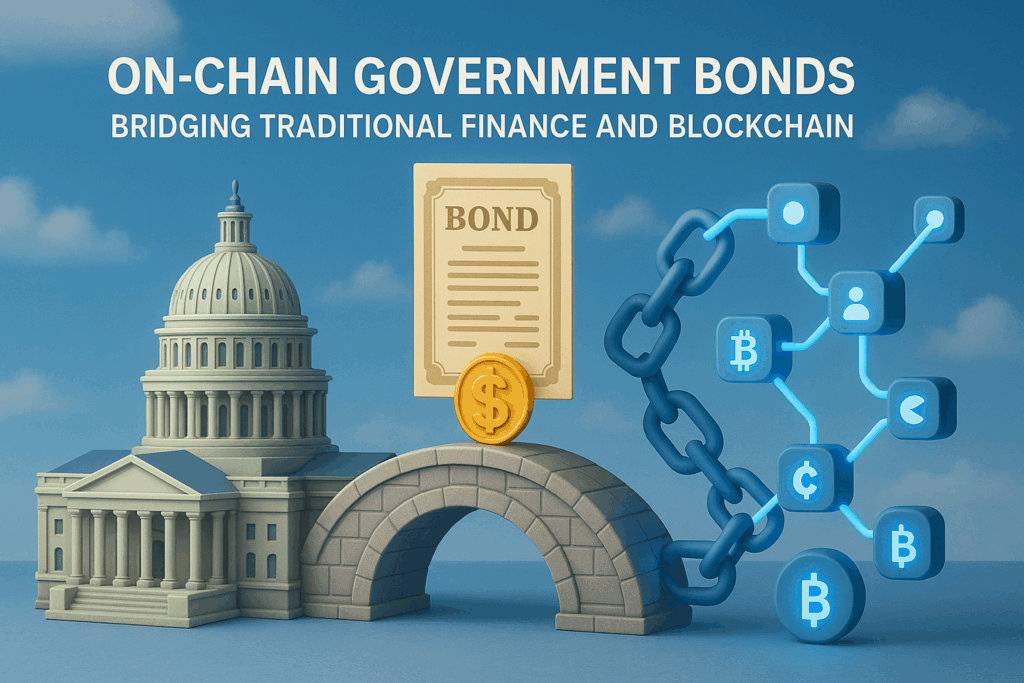On-Chain Government Bonds: Bridging Traditional Finance and Blockchain
Richmond Oppong
April 17, 2025

Introduction
Blockchain technology has already disrupted industries from logistics to healthcare, but one of its most exciting frontiers in 2025 is happening in government finance: on-chain government bonds. This trend represents a pivotal shift where countries are beginning to issue sovereign debt, such as treasury bills and bonds, directly on blockchain networks. This has resulted in more transparent, accessible, and efficient financial systems that could redefine how governments raise and manage public funds.
What Are On-Chain Government Bonds?
On-chain government bonds are digitally issued debt instruments that exist entirely on a blockchain. Just like traditional government bonds, they allow a government to borrow money from investors with a promise to pay it back later, with interest.
However, instead of issuing paper certificates or using centralized databases, these bonds are:
- Digitally tokenized
- Issued and traded on blockchain platforms
- Transparent and traceable in real-time
- More accessible to retail and global investors
This is a significant development in the decentralization of public finance.
Why Governments Are Moving to the Blockchain
Governments are increasingly recognizing the benefits of blockchain for financial instruments. Here’s why:
- Transparency and Trust : Blockchain’s immutable ledger ensures every bond issuance, transfer, and repayment is recorded publicly, fostering trust in government borrowing.
- Reduced Costs: Blockchain eliminates many middlemen like clearinghouses and custodians, reducing administrative and transactional costs for governments and investors alike.
- Global Access: Digital bonds can be offered to investors worldwide with fewer barriers, enhancing a country’s access to capital markets.
- Programmable Features: With smart contracts, interest payments and bond maturity processes can be automated, minimizing the risk of error or delay.
Real-World Examples in 2025
Several nations and institutions have already taken bold steps in this direction:
- El Salvador launched its long-awaited Bitcoin-backed “Volcano Bonds” on a public blockchain, designed to attract crypto investors while funding infrastructure.
- Singapore and Hong Kong have piloted digital government bonds using distributed ledger technology through platforms like Project Guardian and Bond Connect.
- Brazil’s central bank has partnered with blockchain providers to explore sovereign debt issuance on a permissioned blockchain network.
These actions show that more people agree that blockchain can help update and open up access to government debt for everyone.
The Impact on Traditional Financial Markets
On-chain bonds have the potential to reshape the role of central banks, investment firms, and exchanges. Here’s how:
- Decentralized Finance (DeFi) platforms could become alternative venues for government debt trading.
- Retail investors may gain access to markets that were traditionally reserved for institutional players.
- Financial inclusion could improve dramatically in emerging economies where traditional banking systems are less accessible.
Also, tokenized bonds can be used in automated earning or loan systems, creating new ways to use them in the DeFi world.
Risks and Considerations
Despite the promise, this trend is not without its challenges:
- Regulatory uncertainty still surrounds blockchain-based financial instruments.
- Cybersecurity remains a major concern for high-value, public-sector digital assets.
- Interoperability between legacy systems and blockchain platforms can be technically complex.
To move forward, governments must develop robust legal frameworks and infrastructure to ensure these bonds are safe, enforceable, and widely accepted.
Conclusion
The introduction of on-chain government bonds is more than a technical upgrade. It’s a strategic move toward a more open, efficient, and inclusive financial future. As more governments adopt this model, we may witness a transformation in global capital markets, where blockchain serves as the new foundation for trust and transparency in public finance.
For both investors and governments, the blockchain era of sovereign debt has officially begun.
References
- a16z Crypto. (2025). Big Ideas in Crypto for 2025: From On-chain Bonds to zkApps. Retrieved from https://a16zcrypto.com/posts/article/big-ideas-trends-2025
- CoinDesk. (2024). El Salvador’s Bitcoin Bond Gets Closer to Launch. Retrieved from https://www.coindesk.com
- World Bank. (2024). Tokenized Bonds: How Blockchain is Reshaping Public Finance. Retrieved from https://www.worldbank.org
- Monetary Authority of Singapore. (2025). Project Guardian: Tokenized Bonds and Interbank Transfers. Retrieved from https://www.mas.gov.sg
- BIS Innovation Hub. (2024). Central Bank Digital Bonds: A Technical Perspective. Retrieved from https://www.bis.org
The Future of Blockchain in Supply Chains
Feel Free To Contact Us
Wada plan to collaborate with trusted local and international electronic and print media outlets to inform the public about decentralized applications to accelerate adoption.
- hello@wada.org
